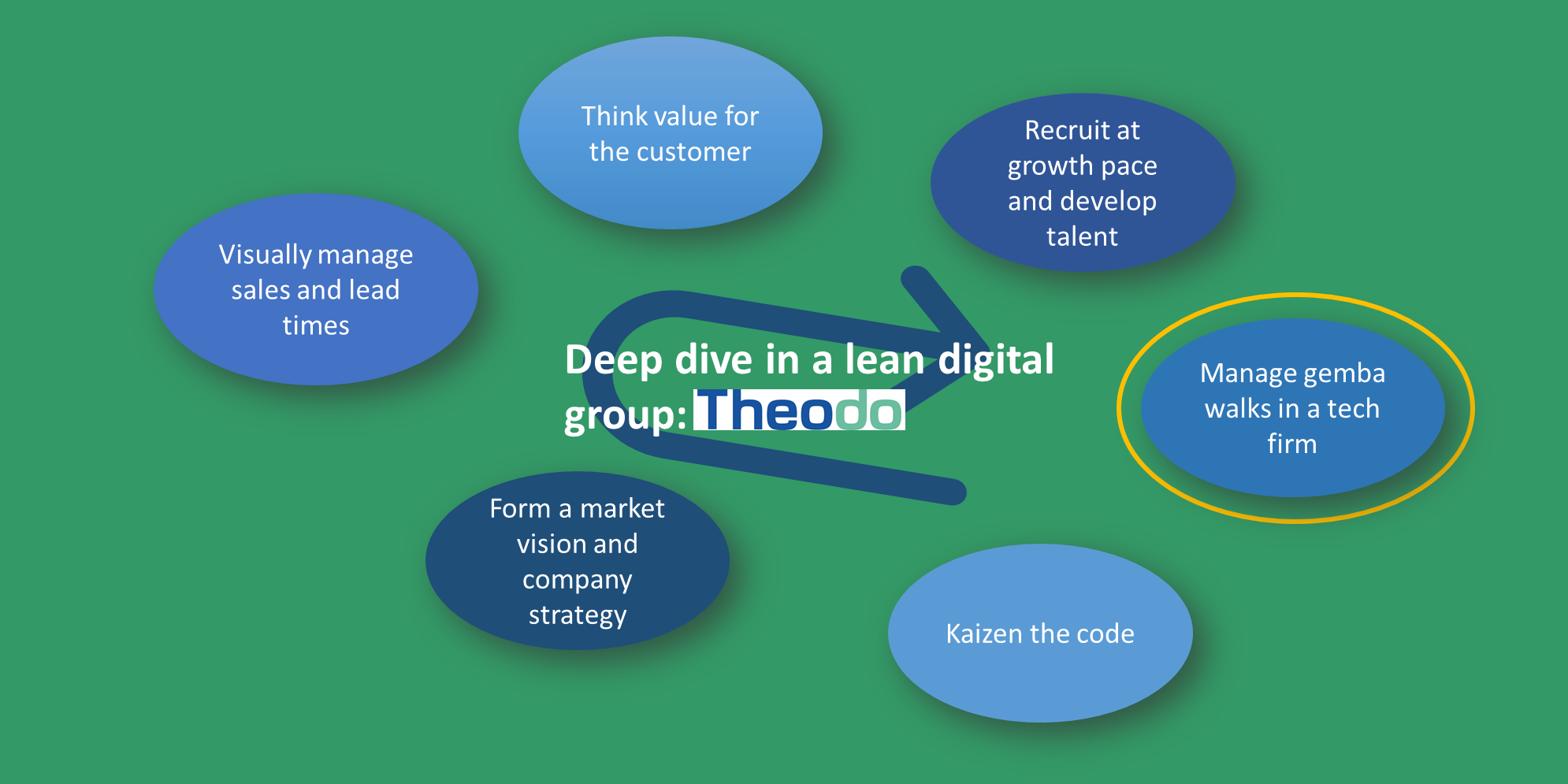
The power of jeans - Part 2
FICTION – In the second and final part of this story, the main characters discuss in front of a board. If you regularly use visual management, their conversation will resonate with you.
Words: Edward Blackman and Hannah Hutson
Jude started with their title of CEO at the top of the marker board, then wrote vertically towards the bottom of the board: VP, Director, Manager, Supervisor, and Front-Line Staff. Next to the titles, Terry created a column titled Acme for their company and another column titled NUMMI.
“Okay. What’s next?” asked Jude.
The Continuous Improvement (CI) coach Terry responded, “Let’s carry the example forward. Imagine that NUMMI manufactured jeans instead of cars; and that as a show of cultural company support, it was required that all employees wear NUMMI brand jeans to work within one year. Now write two numbers at every organizational chart level in the NUMMI column on the marker board. The first number is the goal percentage for ‘jeans transformation’ at each level.”
“That’s easy,” responded Jude. “It’s simply 100% at every level from CEO to Front-Line Staff.” And then, using the green marker, Jude wrote ‘Goal’ under NUMMI to describe the ideal state and the numbers at each level.
Jude continued, “Write ‘Actual’ next to ‘Goal’, and then the current state number for each.”
“Since this is a hypothetical example, I’m going to assume that since the company policy was just announced and no one is compliant.” Jude then wrote 0% at every level in red marker.
“Before the joint partnership between GM and Toyota at NUMMI, it was common for companies like GM to announce annual strategic goals and then check at the end of the year during annual performance evaluations to see if the goals were met,” said Jude.
“Ah, yes. The classic ‘Spray & Pray’ technique for strategy deployment. Spray (or tell) everybody an ambiguous goal, typically by email, and then pray (hope) that everyone not only understands the goal, but also knows how to translate the goal into their daily work. This is one of the most common failure modes for companies deploying their strategies.” said Terry.
“What’s a better approach?” asked Jude.
“I’ve found great success with the strategy development and deployment technique you taught us before, called ‘catchball’, as part of the Hoshin Kanri method mature CI companies use. Not to be confused with that X-Matrix nonsense some consulting company tried to sell me,” said Terry.
Jude responded, “Exactly. We ask leaders at every level to break down large annual goals into quarterly, monthly, weekly, and daily goals, relative to their org levels (VP = quarterly, Director = monthly, etc.). Those leaders throw back-and-forth – that’s why we say ‘catchball’ – those goals as a feedback system of adjusting-to-reality the numbers into operational metrics. Think of the feedback method as mini PDCAs.”
“Jude, we’ve known each other for years, so please don’t be offended by what I am about to say. This is really underwhelming. I know all of this already. You even had me study Pascal Dennis’s excellent book on the topic, Getting the Right Things Done. I’ve started this approach already with my entire C-suite. Granted, we’ve got a way to go yet. I really need help with my top 3 problems: 1) we are losing existing customers, 2) new product development is making glacially slow progress, and 3) cost over runs are killing our financials. Can you help with any of that?”
“I have known you too long and trust your heart too much to be offended by your comments, Terry. Let me take a moment to address your greatest concerns before switching back to addressing leadership behaviors. Granted, this is all speculation, but if your company is like most that are early on their CI journeys, then what we will find is:
- That you’re losing customer because of late shipments, quality defects for delivered shipments, and/or competitors undercutting your prices.
- That NPD is slow because of completely misaligned value streams, last-minute change requests from leadership, and antiquated and incomplete customer needs analysis.
- And that costs are over run due because of the fear of providing real cost estimates at the beginning of project approval toll gates, the outsourcing of code development based on lowest price point instead of best quality and shortest lead time, and the outdated budgeting practices by company silo resulting in perverse incentives.”
“How could you possibly…” started Terry.
“It’s pure speculation. But it is based on what happens at most CI immature companies. From what you’ve seen so far, do you think Acme is unique?” asked Jude.
An enormous sigh followed. “No,” responded Terry.
Jude continued, “The next part of Hoshin Kanri is vital and often neglected. Behaviors. And leads to your assignments. Please individually ask your C-Suite and VPs these questions and tell me what you learned.
- Of your 20 executives (C-suite and VPs), how many can actually state the top three problems you just told me?
- Of your 20 executives, how many refer to any type of document/artifact to help them answer your questions?
- Identify how many projects out of your entire portfolio directly contribute to helping with the top three problems you listed.”
“Also, create a new marker board drawing. This time replace the jeans example with the response you obtain from the three questions. Fill it out for both the Acme and NUMMI columns, please,” added Jude.
Terry’s eyes grew really wide as the enormity of the behavioral CI gap between Acme and NUMMI began to take shape in their mind.
“Let’s get back together in a couple weeks to review your results. Based on the exasperated look on your face, I think you already know what kind of results you will find,” said Jude. “Don’t worry, we will apply a simplified version of the CI Kata technique to address the leadership behaviors. The biggest impact will come from you modeling the desired behavior of simple and systematic problem solving. You will wear jeans first and the other leaders will follow.”
THE AUTHORS


Read more


FEATURE – This month, the author learns how gemba walks happen in a digital environment, where the work and information are typically hidden in computers.


OPINION – What happens when a senior executive jumps the fence and finds himself having to drive the very same change he was asking others to create?


FEATURE – Our disposition towards learning changes depending on the amount of things we don’t know. The author explores this topic and the role of the sensei in enabling learning.


OPINION – A new publicly owned open-source technology promises to make direct, unmediated trade relations trustworthy, opening the door to an era of democratization and cooperation in global commerce.
Read more


FICTION - Part 1 of this story reminds us that the role of leaders in an organization is to set the example for others, behaving the way they want the rest of the company to behave.


FEATURE – We often spend a great deal of time and effort trying to fit our organizations into a box instead of building a box that fits our organization, says Sharon Visser.


THE NAKED GEMBA – This useful article helps us to understand the different type of visual controls we can put in place, how they work and which ones to use to best convey our message.


FEATURE – Hoshin is a powerful management practice that aligns the work at different levels to a company’s strategic goals. The author offers a one-page visual summary.

